Summer pruning is monkey work. I love its simplicity. There is joyously little thought or skill involved. But it is necessary monkey work.
If you want to keep a deciduous fruit tree small and you skip a summer pruning, you start to lose hold on the size and productivity of that tree. So no skipping this summer.
(Why keep a fruit tree small? See my post, “My best advice on pruning deciduous fruit trees: Keep them small.”)
I just gave a couple of my deciduous fruit trees a haircut, and here’s how and why.
How to summer prune
First I pruned the Snow Queen nectarine. Before pruning, it looked like this:
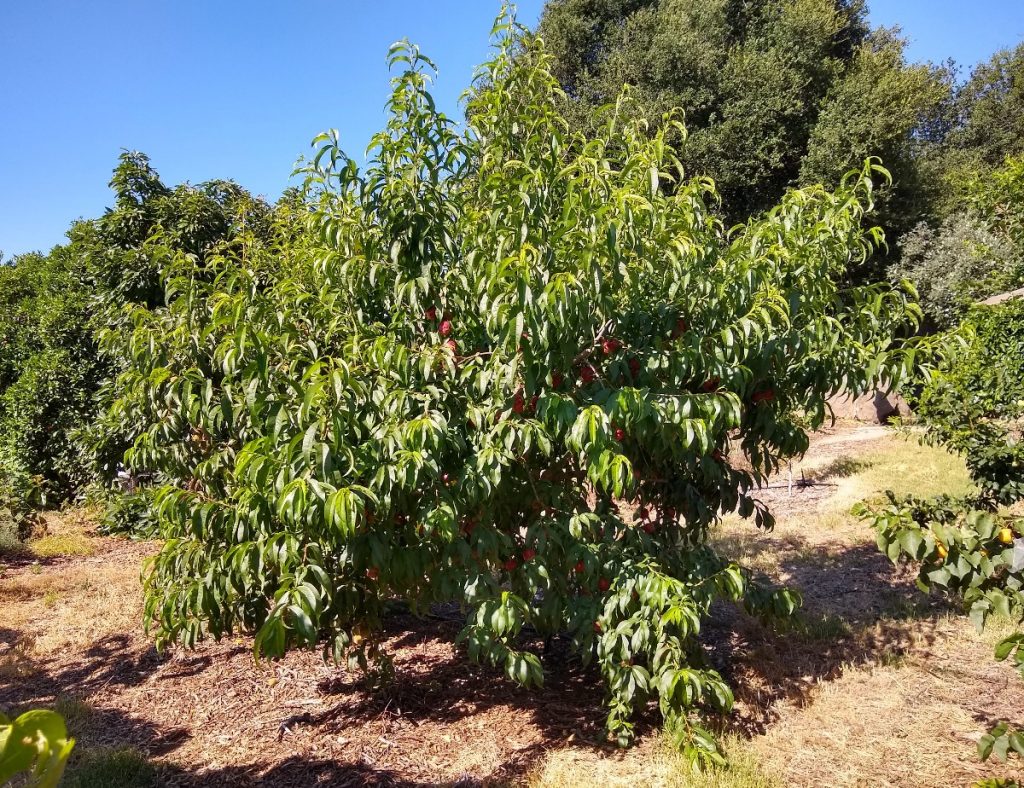
And ten minutes later, it looked like this:
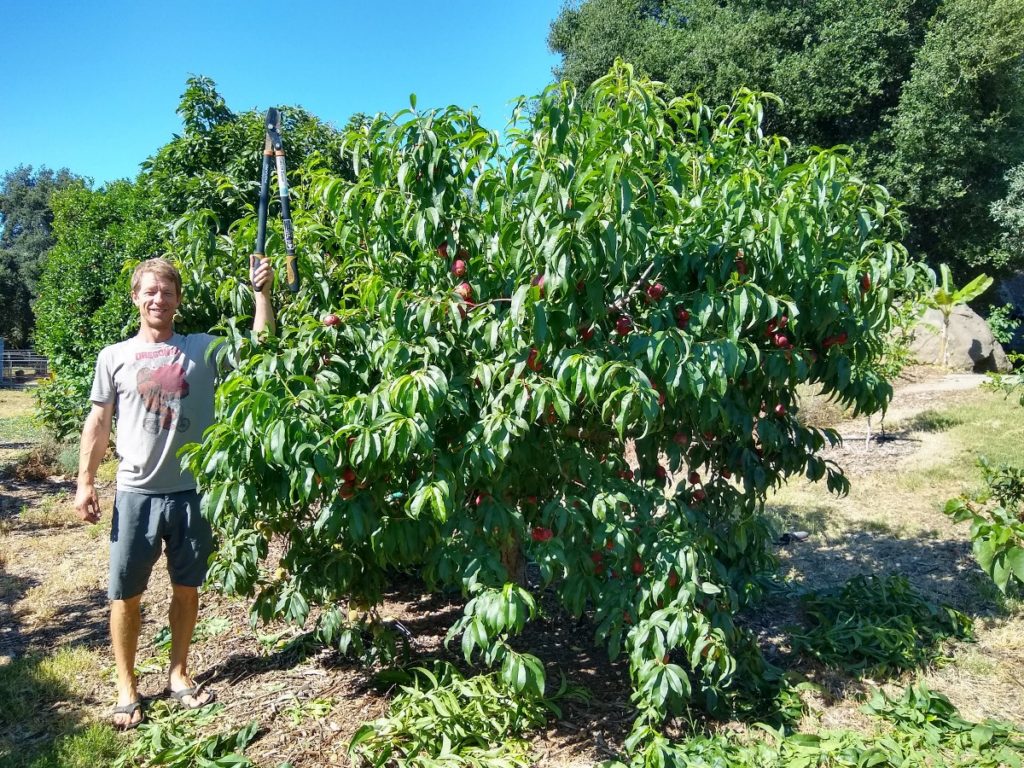
What did I spend ten minutes doing? I simply cut back some side branches so the tree wasn’t crowding the path and other trees nearby, and so I could reach the top of the tree better. There at the top, I cut every branch that was higher than the reach of my loppers. Nothing else to it: just put the loppers over my head and cut, cut, cut.
Summer pruning is like trimming a hedge, and in fact, in commercial orchards summer pruning is often done by machines using buzzsaws.
Why summer prune
What’s the purpose of this simple summer pruning? All you are aiming to do is make sure that the new branches and leaves that have grown in spring don’t shade the lower branches too much — because if they do, then those lower branches won’t make as many flowers as possible next spring. Flowers, of course, become fruit.
If shaded too much for too long, the lower branches will also eventually die.
That would be a shame! Then your one-year old daughter wouldn’t be able to forage her own snacks.

Globe or “open center” tree shapes like my nectarine shown above work well for small fruit trees and so do pyramid or “central leader” tree shapes, like my Flavor King pluot here:
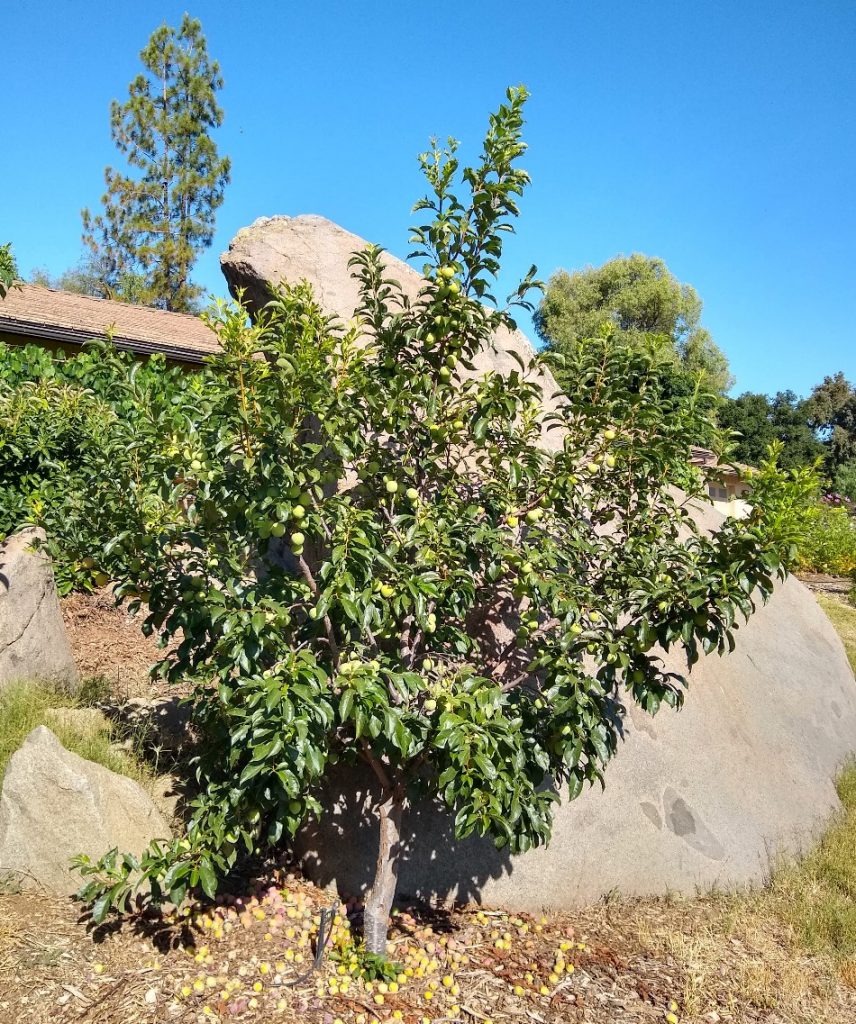
With both tree shapes, your summer pruning has the same aim, which is to make sure enough light is getting to the lower branches. For the globe-shaped tree it is the height of the top growth that intercepts the sunlight and that you must control (in addition to removing some branches from the center, hence “open” center). But for the pyramid-shaped tree it is the width of the top growth that you must control.
So in practice, for a pyramid-shaped tree, you don’t just buzzsaw the top growth flat. You need to make sure the top growth stays pointy and narrower than the bottom.
Here is the Flavor King pluot tree after a light summer pruning:
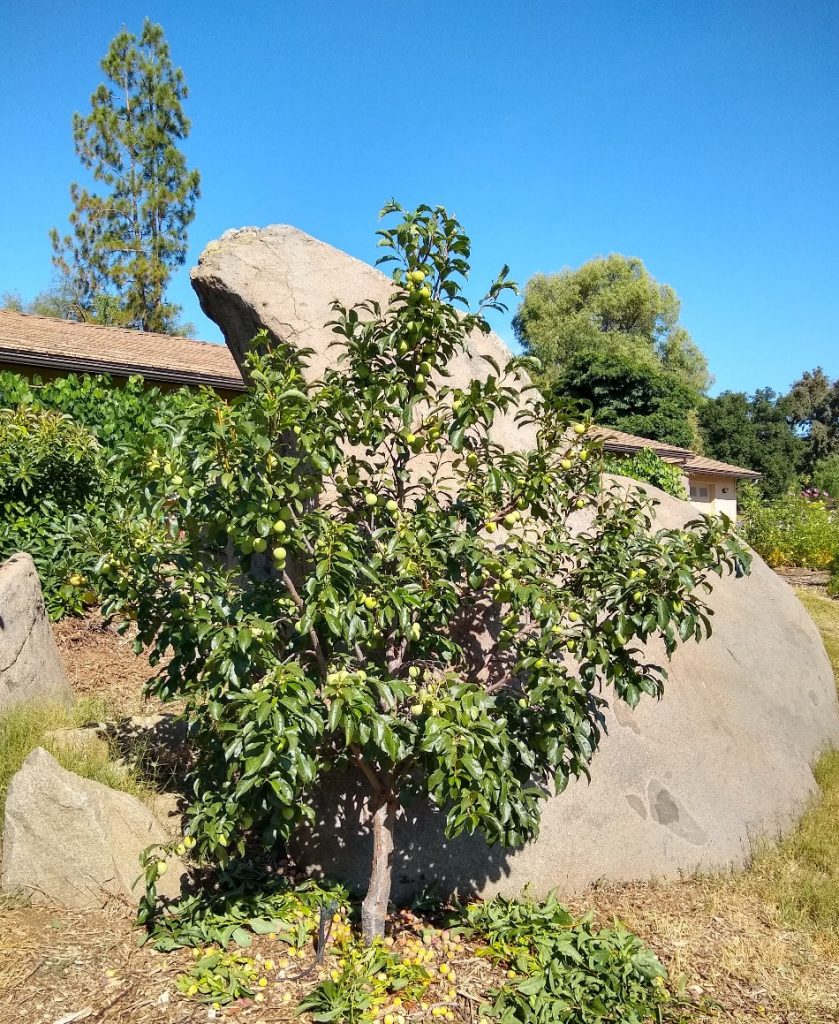
When to summer prune
These trees I pruned here in early July. What determines the timing?
A rule of thumb is to summer prune once the tree has put on approximately two feet of growth. Two feet of new branches and leaves is enough to cause quite a bit of shading to lower branches.
This can happen much earlier than summer, however. One of my fruit trees grew so fast and early this year that I had to “summer” prune it back in May.
On the opposite end of the spectrum, my Blenheim apricot tree still hasn’t grown enough foliage to need pruning. In fact, pruning it now would risk harm. The apricots at the top and outer edges of the canopy would get sunburned if a heatwave hit and there weren’t enough leaves protecting them. It looks like I may not summer prune this tree until well after harvest, sometime in August. It all depends on the pace of growth.
Rewards of summer pruning
The apricot tree has fruit up top, but of course, it also has fruit down low.
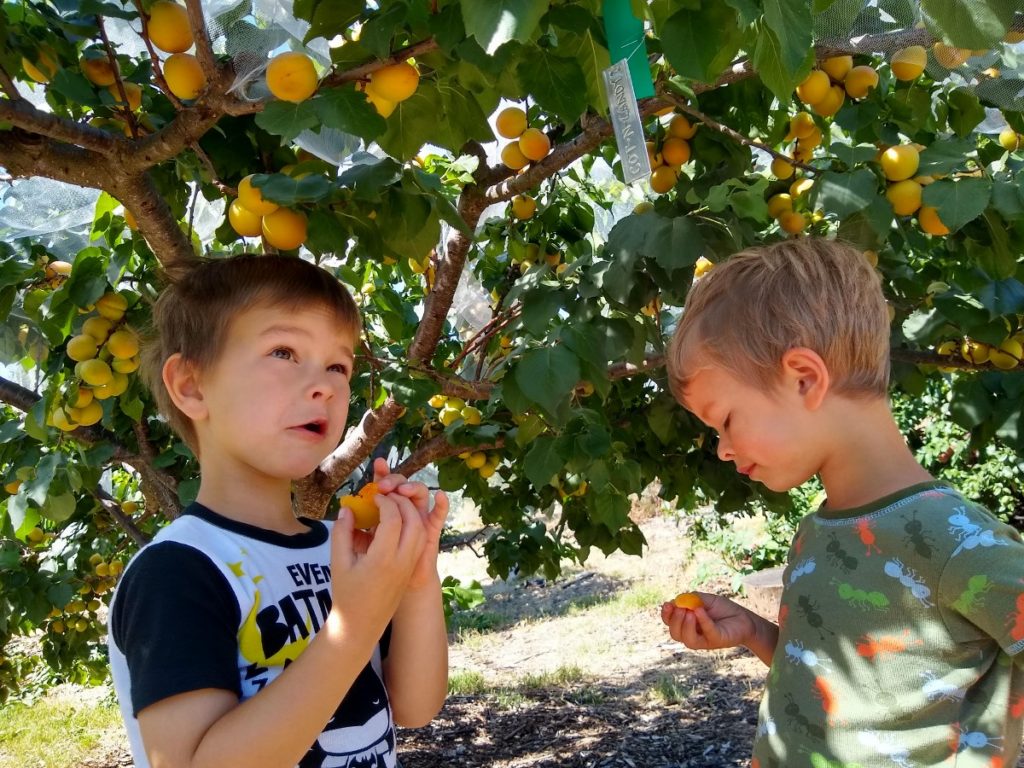
This is the reward for summer pruning: You get fruit up high for mom and dad and fruit down low for the kids.
End note: Summer pruning is for keeping small trees small; it is not the time to cut a 15-foot tree down to eight. Drastic size reduction like that should be done in winter. (If done in summer, sunburn on the branches is likely and overall tree decline is possible, in my experience.)
You might also like to read my other posts about pruning deciduous fruit trees:
My best advice on pruning deciduous fruit trees: Keep them small
Where to cut a branch on a deciduous fruit tree
Pinch to shape young fruit trees
Don’t cut off the fruiting wood: Pruning lesson number one
Think about sunshine when pruning deciduous fruit trees
Or some posts about pruning avocados and citrus:
When and how to prune citrus trees
And here are a couple of useful posts for here in July:

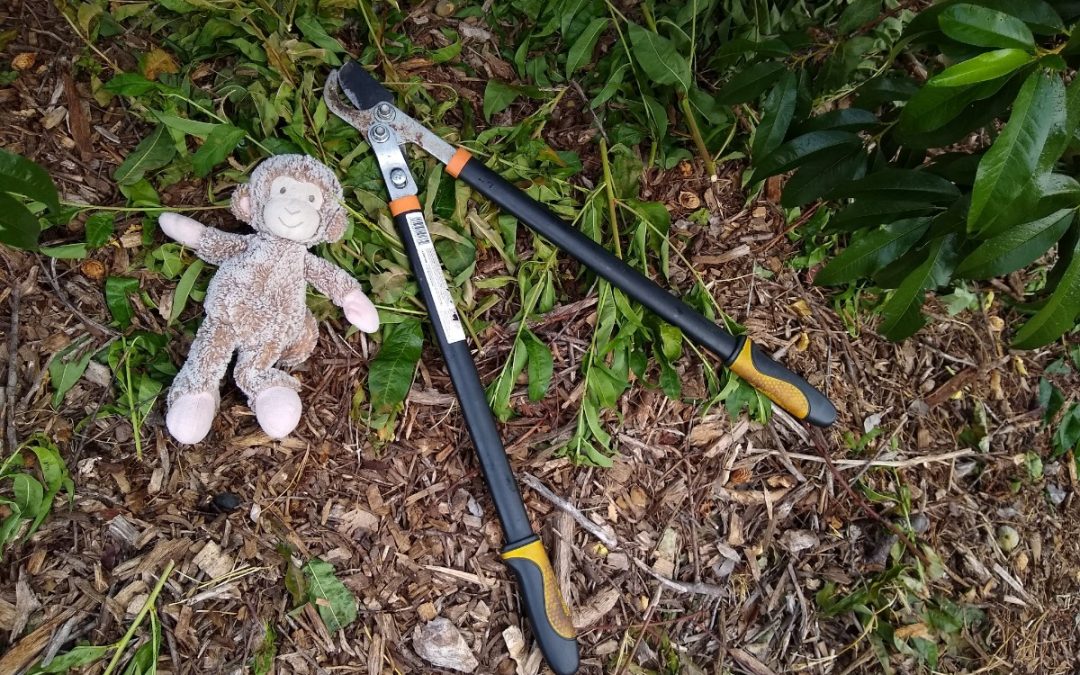


Nothing wrong with hanging out in your PJs and eating fruit straight from the tree.
I was just doing a little trimming today on my peach tree. It needs ALOT more timming!! But I think my fruit may be a little small and immature. On the other hand I’ve noticed that the lower fruit is being eaten by critters. Can I trim them?
Hi Aunt Syndea,
My Babcock peach branch is also growing like crazy. That’s a vigorous variety!
You can definitely trim those lower branches. I’ve had to do some of that too since the weight of the fruit pinned branches to the ground and they’re in the way. Skirt them up, as they say.
I have three zones on my trees: my zone in the middle, the bird and bug zone up higher, and the chicken zone down low. Unfortunately, I haven’t trained the chickens, bugs, and birds to stay away from the middle zone so I’ve decided when I thin the trees I leave about 3 to 4 times what I’m actually going to eat. It seems that by the time the green bugs, gnats, birds, and general rot take their toll I’m left with a good amount to consume. The neighbors cat has really helped with rodents this year.
That’s hilarious! I think of my grapes in a similar way. The low bunches are for the kids and the chickens while the high bunches often get pecked by birds before I bag them, but any middle bunches I normally get to protect on time and allow to mature to full flavor.
I did some Summer pruning on my Spice Zee Nectaplum. It is producing like mad and I have removed 100 fruits, I’m sure, to lighten the load on it’s young branches. I’m afraid I got a little carried away and may have gone overboard on the trimming. There is still quite a lot of fruit on the tree. I hope it doesn’t get too sunburned!
Hi Aunt Renee,
Great to hear that your SpiceZee is doing so well! Luckily, this summer has been mild, and the nectaplum fruit probably isn’t too many weeks from being ready to pick. Let’s hope for no heatwaves for a little longer.
If necessary, you can throw something over the tree or a branch to temporarily shade the fruit during a hot spell — something like shade cloth or tulle fabric or even a light sheet.
Greg, your Blenheim apricot tree has great looking fruit. I have a Blenheim apricot tree with a trunk the diameter of about 5″. It grows like a weed about 6 to 8 feet a year. Several years ago it was loaded with fruit, but before I could pick ripe ones there was something eating them. I put up a trail camera and discovered several families of rats having a party. There was nothing I could put in the traps that they liked better than the apricots. I ended up just putting snap traps around the base of the tree and the rats would get caught as they were partying.
Anyway, here is my question. My apricots would look good until about 3 weeks before picking time and would develop brownish ugly looking skin. The leaves and rest of the tree is healthy and looks normal. I haven’t seen any bugs or fungus. The few decent fruit tasted sweet, but most of the crop was not worth bothering with. I’ve since cut the tree way back, but this year it has had about 6 feet of new growth so far. Any ideas?
Same here with the Blenheim. I think they’re getting sun burnt.
Hi Richard,
You make me glad I don’t have rats to deal with in my yard.
My Blenheim apricots look great wherever they are shaded — as at the bottom of the canopy in that photo — but the ones up high get ugly brown skin, especially those on the south and west sides of the canopy.
That has always made me think it was sun related. And so I’ve never pruned this tree before harvest in order to shade the fruit as much as possible. The fruit down low is always beautiful and tasty; I just sacrifice some fruit up high. This year though, being mild near harvest time here, the fruit all around looks better than in past years.
I wonder if your tree has the same thing going on?
Your post couldn’t be more timely. Just before the 4th I started my summer prune and will be doing so for the next month on various trees, a little later on other trees. I typically wait until the fruit is off the tree or just about ready but still leave enough leaves to shade them until ripe. Each tree pretty much gets a chop to about where I can reach standing on the ground (no ladder). Most of my trees are pruned to the open vase and only a couple are the central leader. Those few trees are let to go a little higher as I need to in order to get them into the sun.
Thanks for your great posts.
the kids are adorable… my avocado tree finally put out nice healthy leaves, looks like the tree is going to make it! My Fruit Punch Mango also put out a flush of healthy growth, no sign of anthracnose left. I have some weird issue with alternate bearing, my fuyu persimmon is loaded to the gills this year with fruit after only having 6 last year but my pomogranate only held on to about 10 blooms that are forming into fruit, there were a ton of flowers that just dropped. Last year it was loaded. Grapefruit tree only has a few fruit blooming as well, last year was loaded. Hope summer is treating you and yours well!
PS I have my summer squash and sugarbaby watermelons by the beehive, I dont’ have to hand pollinate at all this year. Every bloom is turning into fruit, I have to THIN out the developing fruit. I love it!
Should I prune Loquat tree? This is the first year that it produced fruits. It is about 8 feet tall now.
Hi,
I’ve actually never pruned a loquat. Sorry. Are you wanting to keep it small, or are you wondering if you need to prune it for good fruit production? If the latter, then I wouldn’t bother.
Hi Greg,
My summer pruning of deciduous fruit trees is mostly managing sides (width), either so the trees don’t touch (ants) or keeping a pathway. Seems I wind up doing this throughout the summer. I leave the height until the end of summer as most of the trees provide shade to the house. I’ll also remove suckers in the center of trees that would reduce air flow or block light. Looks like we’re going to have good crop of Burgundy plums this year.
Hi Robert,
I could totally picture your trees as you were describing your routine. It makes sense that you prune like that.
I’m jealous of the Burgundy plums. That is an amazingly tasty variety.
Hi Greg,
Thank you for the useful posts. As a beginner in gardening I am grateful for your tips & instructions.
I just harvested my sour Cheries. Is it a good time to do the summer pruning on the tree if so, what type of pruning should be done on this type of tree, globe or pyramid? Thanks in advance.
Hi Zahra,
Thanks. This is a good time to do summer pruning on cherries. I pruned my cherries a few weeks ago (almost exclusively the top, as the sides didn’t need much pruning).
There are many styles of training cherry trees that people use with success. I think you could get good results with either a globe or pyramid shape. For my cherries, I’ve chosen a globe shape and this seems to be working fine so far.
Hi Greg! Is it too late to summer prune a plum tree in Vista? Thanks for the article!
Hi Nancy,
Definitely not too late now. Might have been better a month ago, but now is better than never.
Thank you! Stay safe.